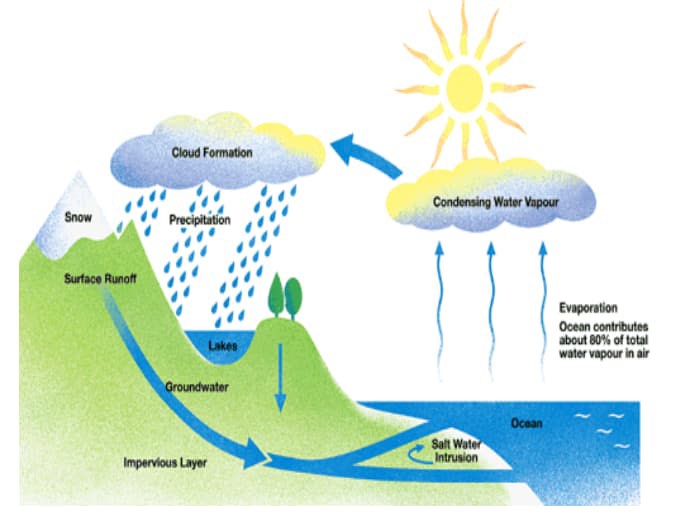This picture illustrates a natural process called the water cycle.
Overview, this process involves 3 stages including evaporation, condensing, precipitation and returning ocean of water. At the first stages, an amount of water is evaporated by the heating of the sun. Scientists estimated that about 80% of water vapour is contributed from ocean. The next stages is a phenomanon called condensing water vapour. This vapour rising high will convert clouds with low temperatures. This process continues until clouds reach saturation, causing precipitation or snowing.
Falling of water establishes lakes, ponds or surface runoff and then they go back to the ocean. In coastal regions where freshwater goes into saltwater happens, a phenomenon is called saltwater intrusion. A part of falling water is absorbed by ground. This water continues go down deep ground, reaching impervious layers, turning into groundwater. This water flows to the ocean.The new cycle continues with beginning of the evaporation
Overview, this process involves 3 stages including evaporation, condensing, precipitation and returning ocean of water. At the first stages, an amount of water is evaporated by the heating of the sun. Scientists estimated that about 80% of water vapour is contributed from ocean. The next stages is a phenomanon called condensing water vapour. This vapour rising high will convert clouds with low temperatures. This process continues until clouds reach saturation, causing precipitation or snowing.
Falling of water establishes lakes, ponds or surface runoff and then they go back to the ocean. In coastal regions where freshwater goes into saltwater happens, a phenomenon is called saltwater intrusion. A part of falling water is absorbed by ground. This water continues go down deep ground, reaching impervious layers, turning into groundwater. This water flows to the ocean.The new cycle continues with beginning of the evaporation

357341846_1386778391.jpg
